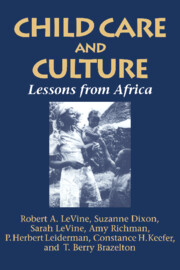Book contents
- Frontmatter
- Contents
- List of tables and figures
- Foreword
- Acknowledgments
- Introduction
- Part I African infancy: Frameworks for understanding
- Part II Parenthood among the Gusii of Kenya
- Part III Infant care and development in a Gusii community
- 6 Infant care: Cultural norms and interpersonal environment
- 7 Survival and health: Priorities for early development
- 8 Communication and social learning during infancy
- 9 Variations in infant interaction: Illustrative cases
- Part IV Interpretations
- Appendix A Fieldwork procedures: Initial phases and planning
- Appendix B Coding categories for spot observations
- Appendix C Blankhart Nutrition Questionnaire
- Appendix D Temperament Assessment Method
- Appendix E Coding categories for narrative observations
- Appendix F Coding categories for face-to-face interaction
- Appendix G Coding categories for maternal teaching task
- Appendix H Supplementary tables
- Notes
- References
- Index
- Plate section
8 - Communication and social learning during infancy
from Part III - Infant care and development in a Gusii community
Published online by Cambridge University Press: 11 May 2010
- Frontmatter
- Contents
- List of tables and figures
- Foreword
- Acknowledgments
- Introduction
- Part I African infancy: Frameworks for understanding
- Part II Parenthood among the Gusii of Kenya
- Part III Infant care and development in a Gusii community
- 6 Infant care: Cultural norms and interpersonal environment
- 7 Survival and health: Priorities for early development
- 8 Communication and social learning during infancy
- 9 Variations in infant interaction: Illustrative cases
- Part IV Interpretations
- Appendix A Fieldwork procedures: Initial phases and planning
- Appendix B Coding categories for spot observations
- Appendix C Blankhart Nutrition Questionnaire
- Appendix D Temperament Assessment Method
- Appendix E Coding categories for narrative observations
- Appendix F Coding categories for face-to-face interaction
- Appendix G Coding categories for maternal teaching task
- Appendix H Supplementary tables
- Notes
- References
- Index
- Plate section
Summary
Gusii parents tend to view infant care primarily in terms of protection and nurturance, and to postpone deliberate instruction until the child is able to talk and understand commands, but the experience and learning of Gusii infants, as for all humans, begins at birth and is culturally organized. Infant psychosocial and behavioral development, though not prominent in Gusii formulations of parental priorities, is culturally shaped even in the early months, anticipating later developmental goals that are salient for Gusii parents. This chapter presents and interprets evidence from naturalistic observations and videotaped samples of elicited caretaker–infant interaction, to provide a portrait of communication and social learning over the first years of life.
A PROFILE OF GUSII MOTHER – INFANT INTERACTION
Describing mother–infant interaction in any human population means, at least implicitly, comparing it with the pattern best known to the child development field, namely, that of the American white middle class, so we shall present Gusii evidence in comparison with observations of middle-class Americans from the suburbs of Boston, Massachusetts, before exploring its meaning and functions from a Gusii perspective.
The overview with which we begin is based on naturalistic observations of Sarah LeVine, who visited each child in the Gusii longitudinal sample at home every 3 months, thus covering children at each 3-month age point between 3 and 30 months, for a 1-hour observation that was subsequently coded. Comparable home observations were later conducted in suburban Boston; Appendix A and Appendix B describe the recording methods and coding categories.
- Type
- Chapter
- Information
- Child Care and CultureLessons from Africa, pp. 196 - 223Publisher: Cambridge University PressPrint publication year: 1994
- 4
- Cited by



